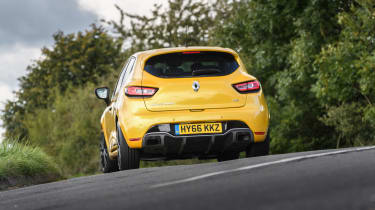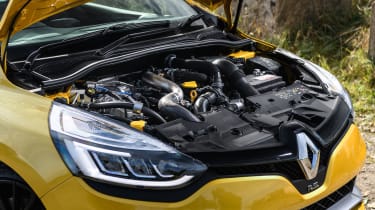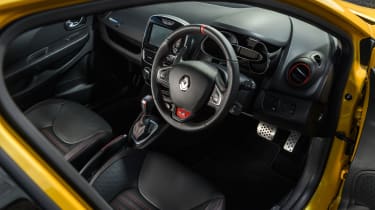Renault Sport Clio 220 Trophy review - Is the turbocharged Clio finally any fun? - Engine and gearbox
The new Clio gets a facelift, a new exhaust and the Trophy becomes a proper production model
The 1618cc turbocharged engine in the Clio 220 Trophy produces a reasonable amount of power, 217bhp at 6050rpm. But exciting it is not. There’s some of the thrill you’d expect from such a heavily turbocharged engine, yet there’s plenty of the downsides. Throttle response is poor except when the revs are close to the red line, and below 5500rpm it feels remote and reluctant to perform.
The noise the engine emits through the optional Akrapovic exhaust is far fruitier than the previous model. The blast-furnace like rush from the exhaust has been replaced by more guttural rasp and sharp cracks at every gear change. The excitement doesn’t grow significantly as the revs rise and its difficult to sense when you’re reaching the upper limit of the engine. The buzzer that sounds when you’re close to the red-line, becomes essential to stop you clattering into the limiter. However, it soon becomes clear that revving the Clio right to the top of its rev-range is slightly pointless; the last 1500rpm seem to have very little effect.
The Trophy still uses the same paddle shift gearbox as the standard Renault Sport Clio 200, rather than a traditional manual. The ‘box in the standard Clio 200 was, by far, the weakest part of the car; the up-shifts were infuriatingly slow and down-shifts rarely happened on the first pull of the paddle. The gearbox in the Trophy is the same, however it’s been totally recalibrated and the stroke of the paddles has been shortened. This results in 50% faster shifts and earlier down-changes under braking.
More reviews
As with the engine though, the gearbox lacks any sort of urgency. Although the shifts are quicker, they aren’t anywhere near as defined or as crisp as the best, or sportiest, double clutch ‘boxes. It also simply isn’t as engaging as a manual ‘box, so although much improved, the gearbox is still an obstacle that stops the Trophy being a really satisfying car to drive.
The gear ratios of standard 200 almost as frustrating as the shift time. 2nd gear feels too low and 3rd too high for most corners; very rarely is there a bend that seems to suit the 200. The gear ratios aren’t any different in the Trophy, but with more power, and more grip thanks to a set of Michelin Pilot Super Sport tyres, cornering speed has increased and 3rd often feels much more appropriate. The ratios still don’t suit the Trophy perfectly, 2nd is still too low, but it’s far less frustrating than in the standard 200.
The paddles themselves are made from metal with a lovely weight to the movement and they’re a pleasure to operate. Rather than mounted on the back of the wheel, they are actually on the column so don’t move when you turn the wheel. This, in itself, isn’t a problem and, even if you’re used to wheel mounted paddles, it’s easy to get used to. But, the paddles don’t extend down enough meaning your fingers find nothing to execute an up-shift when turning right, or to change down when turning left. This seems like an odd oversight to make, as both the paddles extend upwards and around the wheel, just not downwards.
The lack of usable paddle means that you have to reach for the gearknob. None of the time and effort that went into creating satisfying feeling of the paddles went into creating a similar sensation for this bargain basement, plastic lever. In fact, we'd be surprised if any time went into the way it feels at all. Its position is too low and too far back, the materials feel incredibly cheap and the action is both too light and too springy. Thankfully though, you pull back on the stick to change up and push forward to change down. Give us a nasty lump of plastic where the change is correct over a tactile one where you push forward to change up every single day of the week...





